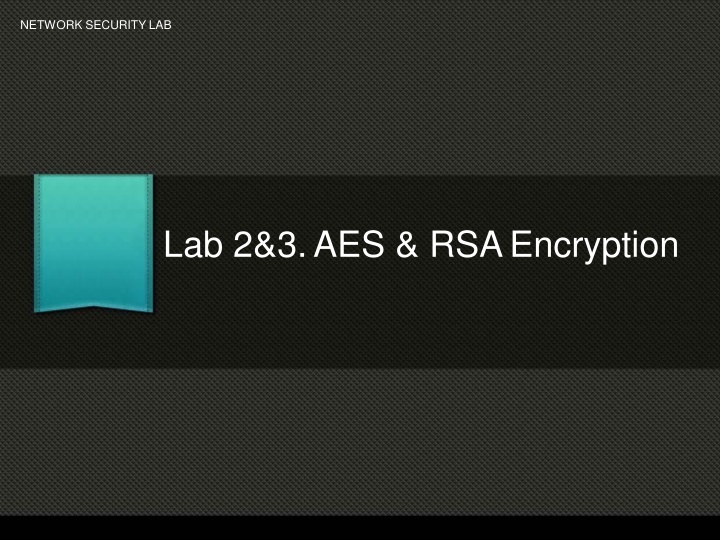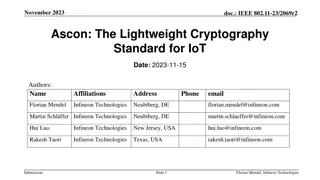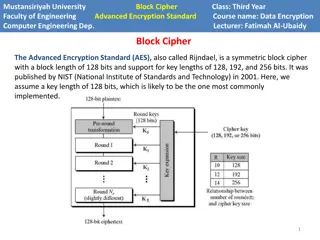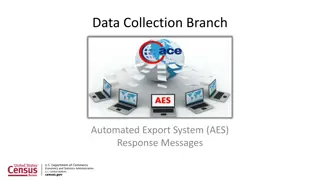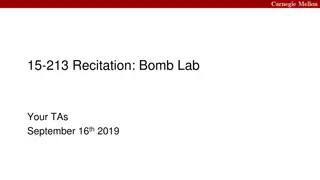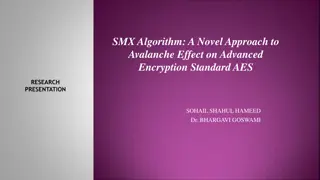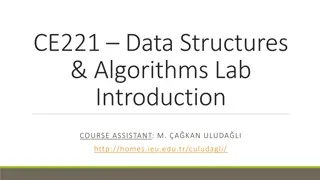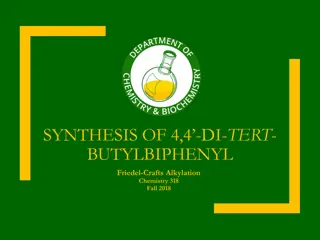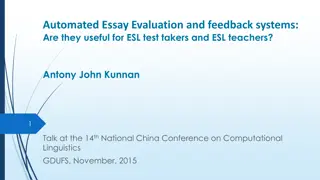Lab 2&3.AES & RSAEncryption
Encryption is the process of converting information or data into codes to prevent unauthorized access. It involves encrypted data, encryption algorithms, keys, and deciphering. Symmetric and asymmetric encryption are common types, with symmetric encryption widely used in databases for its speed and efficiency. Explore the world of encryption technologies and their applications in securing data.
Download Presentation

Please find below an Image/Link to download the presentation.
The content on the website is provided AS IS for your information and personal use only. It may not be sold, licensed, or shared on other websites without obtaining consent from the author.If you encounter any issues during the download, it is possible that the publisher has removed the file from their server.
You are allowed to download the files provided on this website for personal or commercial use, subject to the condition that they are used lawfully. All files are the property of their respective owners.
The content on the website is provided AS IS for your information and personal use only. It may not be sold, licensed, or shared on other websites without obtaining consent from the author.
E N D
Presentation Transcript
NETWORK SECURITY LAB Lab 2&3.AES & RSAEncryption
What is Encryption? The process of converting information or data into codes to prevent unauthorized access
Encryption Data/Information i Encrypted data = cipher = C Encryption Algorithm = E Encryption Key = K Decrypted data = plaintext = d i=E(K,C) OR C= EK(i) d=E(K,C) OR d=EK(C)
Encryption - Terminology Encryption or Enciphering: Process of converting plain text to cipher text. EncryptionAlgorithm: Performs encryption Inputs needed: plain text and secret key Deciphering or Decryption: Process of recovering plain text from cipher Secret Key: used for encryption or decryption
Encryption - Types Symmetric Encryption: Process encryption where same key is used to encrypt and decrypt the data:
Encryption Types (2) Asymmetric EncryptionAKAPKI: Process encryption where public and private keys are used to encrypt and decrypt the data:
Symmetric Encryption- Uses Commonly used in database as there are no two separate end points to send and receive data. Widely used due to its speed factor compared to PKI. Often used in encrypting backup tapes for offline storage and digital streaming. Used to securely store private information, credit card information, etc.,
Symmetric Encryption- Deep Dive Symmetric encryption uses a number of algorithms: Two Fish (Open source) Blow Fish 3DES DES AES In late 1990 s the National Institute for Standards and T echnology (NIST) felt the need for new standard for cryptography.
Symmetric Encryption- Deep Dive (2) Belgian Cryptographers : Vincent Rijmen and Joan Daemen developed theAES. Acquired by Federal Government and named as FIPS197. Widely accepted by the private sector. T esting protocols forAES
HOWAES Works? Requirements: Software that implements theAESAlgorithm Inputs: Data (credit card number, plain text) and Key (encryption key) Plain Text AES Engine Key Encrypted Unreadable binary ryp Data format data Reversal for decryption
AES- Behind the Scene AES is a block cipher Has an Initialization Vector (IV) for rounds of encryption for the data in the block. Size of the block is 16 bytes Encryption Key Sizes: 128 bit (16 Bytes) 192 bit (24 Bytes) 256 bit (32 Bytes)
AES- Strong Encryption Key Encryption Key Apassphrase Should be complex and not a easy guess Use combination of letters, numbers, cases and special characters. Ex: PlayerR@g3!$$ How keys are generated? Random Number Generated (RNG) Password Based Encryption (PBE) = Password + Software for encryption and hashing. Split Passwords = Passwords entered by 2 or more users.
Where can I find AES? Software Vendors: Microsoft IBM SUN Products with Encryption Third party vendors Free subscriptions Online applications Free web applications
AES Functionality The plain text Message
Encryption Initial encryption with Key (128bit)
Encryption Substitution technique for other keys
Keep Iterating Substitution technique for other keys
Application Hands onApplication forAES Encryption http://aes.online-domain-tools.com/
Asymmetric Encryption- RSA Public-Private Key encryptionAKAPKI Developed by Ron, Shamir andAdleman in 1997. Using Public Key and Private key to encrypt and decrypt the messages Encrypts using public key and decrypt using private key
RSAAlgorithm Choose 2 different prime numbers P ,Q Calculate Modulus N = P*Q Calculate T otient X(N) = (P-1) (Q-1) Choose an integer E (Public Key) Should be between 1 and X(N) The GCD (E and X(N) = 1 Calculate D (Private Key)= 1 + K * X(N) / E
RSAAlgorithm (value) Prime numbers P =3 ,Q =5 Calculate Modulus N = P*Q = 15 Calculate T otient X(N) = (P-1) (Q-1) X(N) = (2) (4) = 8
RSAAlgorithm (value 2) Choose an integer E (Public Key) Random selection that should satisfy: Should be between 1 and X(N) (8) The GCD (E and X(N) = 1 Therefore E=7 as its the number Between 1 and 8 GCD of E and X(N) is 1
RSAAlgorithm (value 3) Calculate D (Private Key) Formula D = 1 + K * X(N) / E K will be a random value starting from 0,1,2 Value of K should be less than the value of E=7 The value of k will be changed until the value of equation is an integer and not a fraction Assume K =1 1+1*8/7 = 1+8/7= 9/7 = 1.24 1+2*8/7 = 1+16/7= 17/7 = 2.42 1+6*8/7 = 1+48/7= 49/7 = 7 Therefore the value of D = 7
RSAEncryption Encryption: Cipher = C , Message = M = 2 C = ((M)^E)mod pq C = ((2)^7) mod 15 C= (128) mod 15 C=128 mod 77 = 8
RSAEncryption (2) Cipher: 1446436027249695724085187034261343407637345227512175264736046413631785764689 5726366662225378971531954686536966572938530962015355961280039128824192279946 1900336928606242039205889723393039751165794039846990733677929842721509238963 3158926727411186195914142933026219981117920960369465642159463357586198511098 7540055893001309752836398564218504892953596650409594770352818416521701283436 8463658830038592096291421132889989793954497271306896737716409455275151550293 8623905950509780011746717729167078502200271395230314167889507200139908687846 5401346837727212873235227364587270216164844338039376435790769437622961938823 3504142648252743944924390551560704492709089383951117980259418257445822558139 1615536441987006546174978414995768699027758443604904566916432858899133931230 5897118534509075405405954247767707520522917844002365256660070562128174601189 4818223044281817138874614763635023450960993983575312156062075089134523100430 036429569055865730319563634831414589143605553545057773590087890625 Mod: 65
RSADecryption Message M = (C^D) mod PQ M = (8^7) mod 15 M = 2097152 mod 15 M = 2
REPORT WORK Prepare a brief write up on the different components of theAES Encryption. Explain in short the process of encryption inAES.
